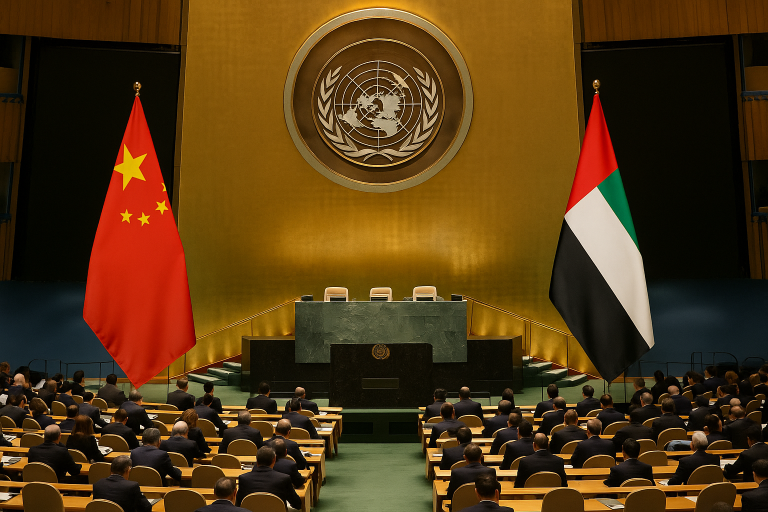Financial Innovation Hub: UAE-China Banking and Investment Synergies
Introduction
In the rapidly evolving world of global finance, a powerful new corridor of innovation and investment is being forged between the United Arab Emirates and the People’s Republic of China. This burgeoning financial partnership is quickly becoming a dynamic hub where the UAE’s established role as a global financial gateway and China’s vast and expanding capital markets are creating profound synergies. This is not just a story of increasing transaction volumes; it is a narrative of strategic integration, where banking networks, capital markets, and cutting-edge financial technology (FinTech) are converging to reshape the landscape of international finance. The UAE-China financial relationship is a cornerstone of their Comprehensive Strategic Partnership, a forward-looking alliance that is building the infrastructure for the next generation of global economic activity. This article explores the key dimensions of this financial partnership, from the foundational banking backbone that supports their immense trade to the pioneering collaborations in digital currencies and the shared vision for a deeply integrated financial future.
The Banking Backbone: Supporting Bilateral Trade and Investment
The phenomenal growth in China-UAE trade and investment, which now exceeds $100 billion annually, would not be possible without a robust and sophisticated banking infrastructure. Recognizing this, both countries have actively fostered the expansion of their banking networks into each other’s territories. The UAE’s premier financial centers, the Dubai International Financial Centre (DIFC) and the Abu Dhabi Global Market (ADGM), now host a significant presence of China’s largest state-owned banks, including the Industrial and Commercial Bank of China (ICBC), Bank of China, and Agricultural Bank of China. These institutions play a critical role in providing trade finance, project lending, and corporate banking services to the thousands of Chinese companies operating in the region.
This presence is reciprocal, with major Emirati banks expanding their footprint in mainland China and Hong Kong to service UAE-based companies and investors active in the Chinese market. This interwoven network of financial institutions is the essential plumbing of the economic partnership, ensuring the smooth and efficient flow of capital. A crucial element of this framework is the currency swap agreement between the central banks of the UAE and China. This agreement allows for trade and investment to be settled directly in the UAE Dirham (AED) and the Chinese Yuan (RMB), a mechanism that reduces transaction costs, mitigates foreign exchange risk, and lessens the reliance on third-party currencies like the US dollar. This move towards greater use of local currencies is a clear sign of the deepening trust and strategic maturity of the financial relationship.
Integrating Capital Markets: A Two-Way Flow of Investment
Beyond commercial banking, the integration of the two nations’ capital markets is a rapidly advancing frontier. The UAE’s formidable sovereign wealth funds and large institutional investors have become significant players in China’s domestic capital markets. Through programs like the Qualified Foreign Institutional Investor (QFII) scheme, these Emirati investors are gaining greater access to China’s vast and growing equity and bond markets, allowing them to diversify their portfolios and tap into the long-term growth story of the Chinese economy.
This investment flow is increasingly a two-way street. Chinese institutional and individual investors are looking to the UAE’s stable and well-regulated markets for opportunities in sectors like real estate, technology, and financial services. The listing of Chinese companies on Dubai’s stock exchanges, such as Nasdaq Dubai, is a particularly noteworthy trend. Such listings provide these companies with access to a diverse pool of regional and international capital while simultaneously enhancing the depth and global profile of the UAE’s capital markets. This cross-listing activity creates a powerful bridge, connecting the capital pools of both nations and fostering greater financial integration.
FinTech and Digital Innovation: Building the Future of Finance
Perhaps the most exciting and forward-looking aspect of the China-UAE financial partnership is the collaboration in FinTech and digital innovation. The UAE has firmly established itself as the leading FinTech hub in the Middle East, creating a regulatory environment and ecosystem that actively attracts innovators from around the world. Chinese FinTech firms, global leaders in areas like digital payments, blockchain, and artificial intelligence, have been drawn to this vibrant ecosystem, using the UAE as a launchpad for their regional expansion.
The impact of this collaboration is already visible to consumers and businesses. The widespread integration of Chinese digital payment platforms like Alipay and WeChat Pay across the UAE’s retail and hospitality sectors has made transactions seamless for the hundreds of thousands of Chinese tourists and residents. However, the cooperation goes much deeper, extending to the very future of money itself.
Case Study: The mBridge Project
A groundbreaking example of this collaboration is the mBridge project. This initiative brings together the central banks of the UAE and China, along with those of Hong Kong and Thailand, to explore the use of central bank digital currencies (CBDCs) for cross-border payments. The project aims to develop a platform that allows for instantaneous, low-cost, and secure international transactions, bypassing the complexities and inefficiencies of the current correspondent banking system. The successful implementation of mBridge could revolutionize trade finance, dramatically reducing the time and cost of cross-border business. The active participation of both the UAE and China in this project places them at the absolute forefront of global financial innovation.
The Future of the Financial Corridor: A Vision for Deeper Integration
The trajectory of the UAE-China financial partnership points towards even deeper integration in the years to come. A significant area of future growth is green finance. With both nations making massive commitments to sustainable development and the energy transition, there is a tremendous opportunity to create joint investment funds and issue green bonds to finance renewable energy and sustainable infrastructure projects. By combining the UAE’s expertise in project finance with China’s scale in green technology, they can become global leaders in financing the fight against climate change.
Continued efforts to harmonize financial regulations and standards will also be crucial, creating a more seamless environment for cross-border investment and financial services. In this complex and evolving landscape, the UAE China Chamber of Commerce (UECN) is an indispensable guide. The Chamber plays a vital role in connecting financial institutions, promoting investment opportunities, and providing its members with critical insights into the regulatory and market dynamics of both countries, empowering them to navigate this golden era of financial cooperation.
Conclusion: A Golden Partnership in a New Era of Finance
The financial partnership between the UAE and China is a powerful engine of their Comprehensive Strategic Partnership. It is a multi-layered and synergistic relationship, built on a strong banking backbone, increasingly integrated capital markets, and a shared ambition to lead the world in financial innovation. This is a golden partnership that is not only creating immense economic value for both nations but is also contributing to the development of a more efficient, inclusive, and resilient global financial system. As they continue to deepen their collaboration in areas from digital currencies to green finance, the UAE and China are not just building a financial corridor—they are helping to design the future of international finance itself.







